Industrial Automation Control Market Size 2025-2029
The industrial automation control market size is valued to increase USD 160 billion, at a CAGR of 12.3% from 2024 to 2029. Need for simplification of complex manufacturing activities will drive the industrial automation control market.
Major Market Trends & Insights
- APAC dominated the market and accounted for a 38% growth during the forecast period.
- By Product - Sensors segment was valued at USD 36.10 billion in 2023
- By End-user - Process industry segment accounted for the largest market revenue share in 2023
Market Size & Forecast
- Market Opportunities: USD 160.79 billion
- Market Future Opportunities: USD 160.00 billion
- CAGR : 12.3%
- APAC: Largest market in 2023
Market Summary
- The market is a dynamic and continually evolving landscape, driven by the increasing need for simplification of complex manufacturing activities. Core technologies, such as Programmable Logic Controllers (PLCs) and Distributed Control Systems (DCS), are at the heart of this market, enabling efficient and automated production processes. In addition, the adoption of open platform architectures for automation software is on the rise, allowing for greater interoperability and flexibility. However, this market is not without challenges. Exposure to cybersecurity threats is a major concern, with the increasing use of connected devices and the Internet of Things (IoT) in industrial automation.
- According to a recent report, cybersecurity spending in the manufacturing sector is projected to reach 2.4 billion USD by 2023, representing a significant investment in securing these systems. Despite these challenges, opportunities abound, with the market expected to grow as industries continue to seek ways to optimize their manufacturing processes and improve operational efficiency.
What will be the Size of the Industrial Automation Control Market during the forecast period?
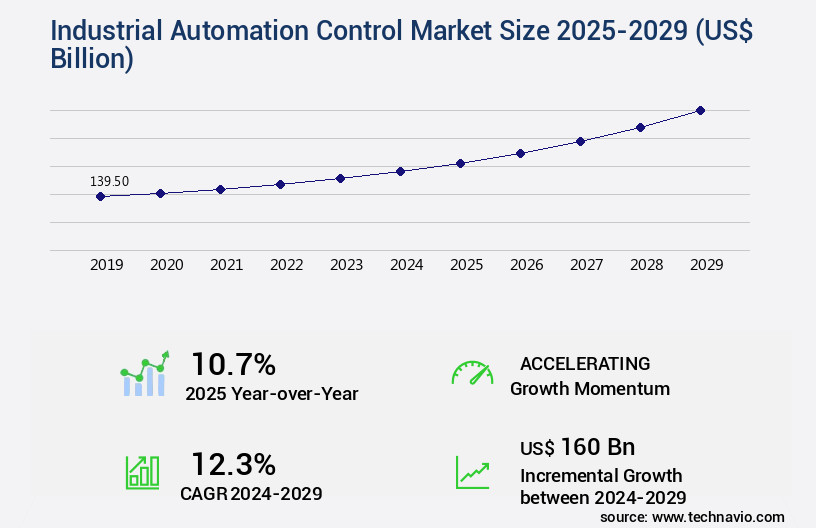
Get Key Insights on Market Forecast (PDF) Request Free Sample
How is the Industrial Automation Control Market Segmented and what are the key trends of market segmentation?
The industrial automation control industry research report provides comprehensive data (region-wise segment analysis), with forecasts and estimates in "USD billion" for the period 2025-2029, as well as historical data from 2019-2023 for the following segments.
- Product
- End-user
- Process industry
- Discrete industry
- Component
- Geography
- North America
- Europe
- APAC
- China
- India
- Japan
- South Korea
- South America
- Rest of World (ROW)
By Product Insights
The sensors segment is estimated to witness significant growth during the forecast period.
In the dynamic and evolving landscape of industrial automation, various technologies play pivotal roles. Machine vision, digital twins, and HMI design enhance production efficiency and quality. Cloud-based automation, feedback control loops, and sensor integration ensure seamless data acquisition and real-time control. Cybersecurity in automation safeguards systems from potential threats. Process automation, remote monitoring, SCADA systems, and process optimization streamline operations and improve energy efficiency. Safety instrumented systems, actuator control, and fieldbus networks ensure reliable and safe industrial processes. Real-time control, control algorithms, motion control, and edge computing optimize performance and productivity. Robotics integration and machine learning algorithms expand automation capabilities.
Industrial communication protocols, such as Industrial Ethernet, facilitate data exchange between devices. Data acquisition and actuator control enable precise process control. According to recent studies, 30% of industrial enterprises have adopted sensor technology, with an expectation of 35% growth in sensor adoption within the next three years. Additionally, 28% of industrial organizations plan to invest in cloud-based automation solutions, anticipating a 32% increase in implementation within the same timeframe. These trends underscore the continuous evolution and expansion of the industrial automation market.
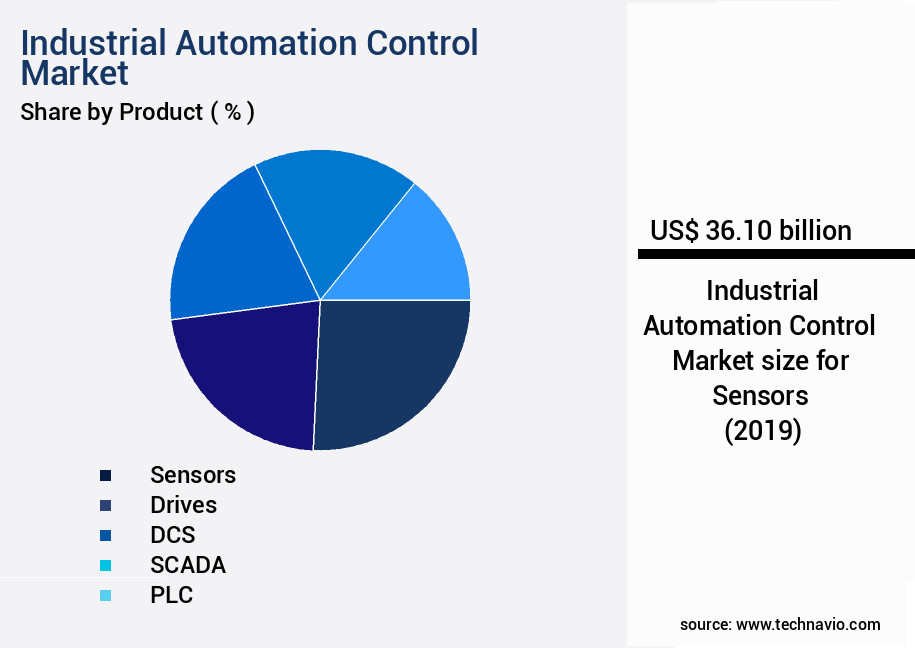
Request Free Sample
The Sensors segment was valued at USD 36.10 billion in 2019 and showed a gradual increase during the forecast period.
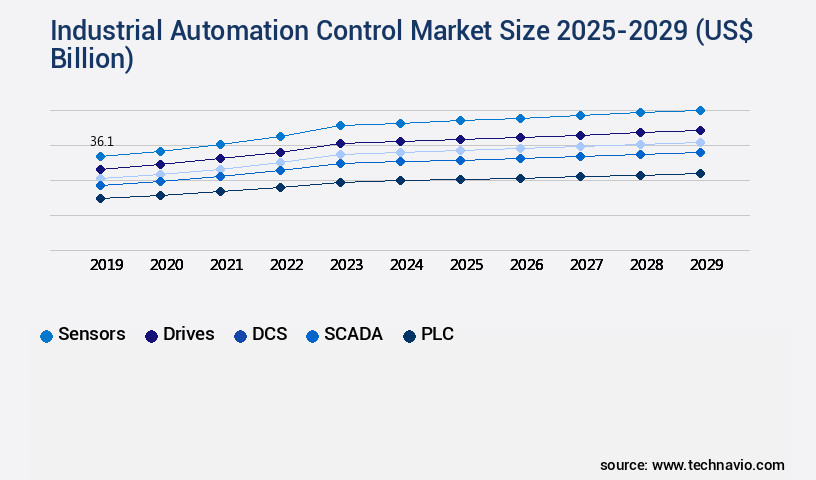
Request Free Sample
Regional Analysis
APAC is estimated to contribute 38% to the growth of the global market during the forecast period.Technavio’s analysts have elaborately explained the regional trends and drivers that shape the market during the forecast period.
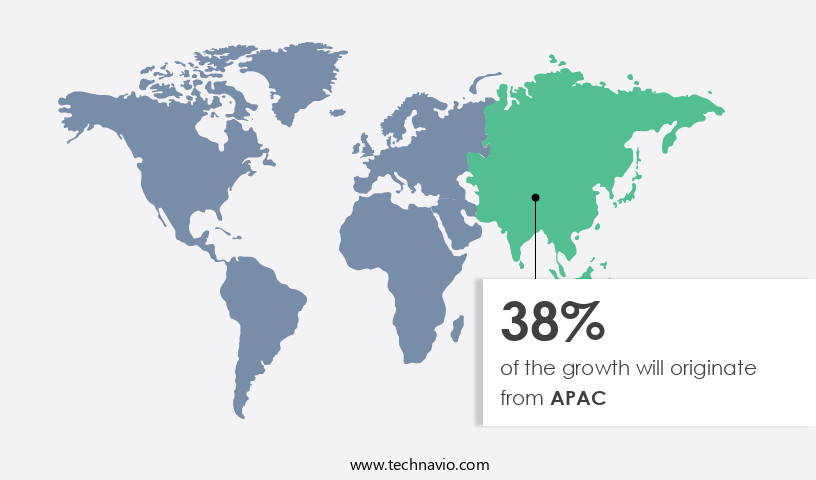
See How Industrial Automation Control Market Demand is Rising in APAC Request Free Sample
The market in APAC is experiencing substantial growth, with China, Japan, India, Vietnam, South Korea, Malaysia, and Australia leading the charge. These countries' industrialization and substantial investments in industries such as power, water and wastewater treatment, food and beverage, and oil and gas are driving market expansion. In APAC, the oil and gas sector is witnessing a surge in projects, with both downstream and midstream investments increasing.
China, Japan, South Korea, and India are the region's largest markets for industrial automation control solutions due to their significant industrial activities. The high energy demand in the region is fueling the commencement of numerous oil and gas projects, making the market a significant contributor to the industrial sector's growth.
Market Dynamics
Our researchers analyzed the data with 2024 as the base year, along with the key drivers, trends, and challenges. A holistic analysis of drivers will help companies refine their marketing strategies to gain a competitive advantage.
The market encompasses a range of technologies and systems designed to optimize manufacturing processes, enhance productivity, and ensure safety in various industries. Key components of this market include PLC programming for automated systems, SCADA system integration with industrial robots, and implementing predictive maintenance using IIoT. PLC programming plays a crucial role in automating industrial processes, enabling seamless communication between various components. SCADA systems, meanwhile, facilitate integration of industrial robots, optimizing production lines and improving overall efficiency. Predictive maintenance using IIoT is another significant trend, allowing manufacturers to anticipate equipment failures and minimize downtime. Designing efficient HMIs for process automation and improving energy efficiency are also essential aspects of the market.
Cybersecurity threats in industrial control systems pose a significant challenge, necessitating robust solutions to protect against potential breaches. Remote monitoring of industrial processes using cloud technology and data analytics for production optimization are other key trends. The integration of AI and machine learning in automation systems is transforming industrial processes, enabling advanced control algorithms for process control and safety instrumented systems for industrial automation. The market's focus on robustness and reliability of automation systems is evident in the growing adoption of system upgrade and migration strategies. Effective operator training for industrial automation is essential for ensuring a smooth transition to automated processes.
Adoption rates for industrial automation in the manufacturing sector are significantly higher compared to the construction industry, with more than 80% of manufacturing companies investing in automation technologies. This underscores the market's potential for growth and the importance of staying informed about the latest trends and developments.
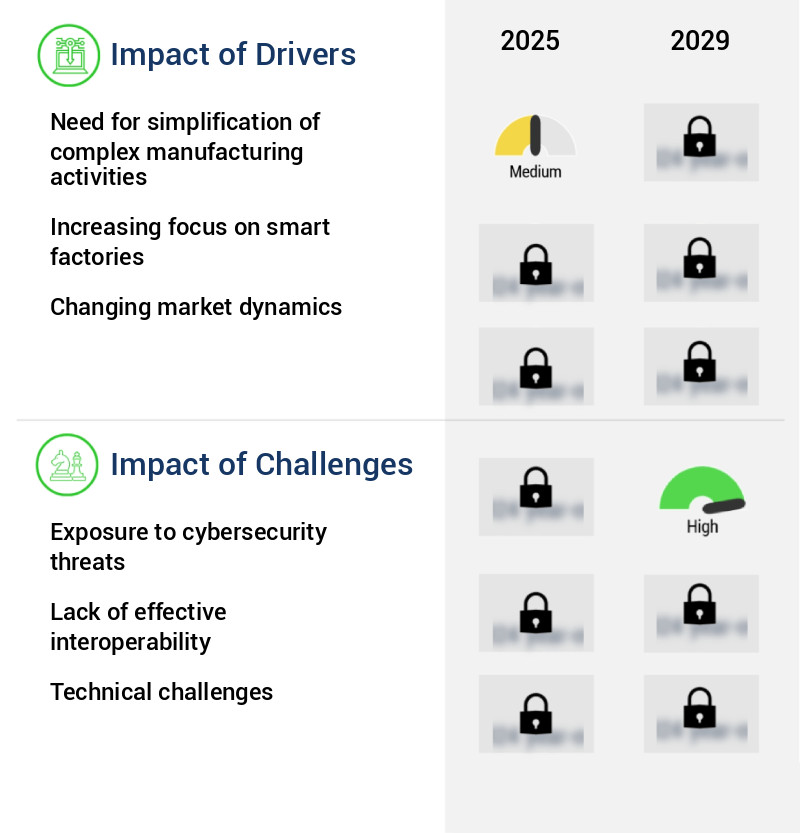
What are the key market drivers leading to the rise in the adoption of Industrial Automation Control Industry?
- The imperative need for simplifying intricate manufacturing processes serves as the primary market catalyst.
- In the ever-evolving industrial landscape, managing plant assets has emerged as a critical priority for operators. The intricacy of the production process has escalated, given the manufacturing of diverse products with distinct attributes due to fluctuating demand. The interconnected nature of production equipment, inventory, and support systems in various industrial facilities creates a complex operational environment. Asset-intensive industries, such as oil and gas, food and beverage, and water treatment, necessitate advanced tools and techniques to grasp the multifaceted knowledge embedded in intricate production models. Industrial automation control systems, including SCADA, DCSs, and PLCs, play a pivotal role in overseeing numerous complex processes, operations, and systems within industrial plants.
- These control systems facilitate real-time monitoring, data collection, and analysis, enabling operators to optimize production, minimize downtime, and enhance overall plant performance. By integrating advanced technologies like AI and machine learning, these systems can predict potential issues, automate routine tasks, and provide valuable insights for continuous improvement. The application of industrial automation control systems has expanded beyond traditional manufacturing applications, reaching sectors like agriculture, healthcare, and utilities. The ongoing evolution of these systems underscores their importance in managing the intricacies of modern industrial processes and maintaining a competitive edge in today's market.
What are the market trends shaping the Industrial Automation Control Industry?
- The increasing requirement for open platform architectures is a notable trend in the automation software market.
Open platform architectures are increasingly demanded in the automation software market.
- Industrial automation control solutions play a crucial role in managing and regulating manufacturing plant functions. Open platforms for automation software are increasingly popular, enabling users to customize and modify software functionality. This empowers original equipment manufacturers (OEMs) to boost their product's operational capabilities and expand connectivity options, addressing interoperability challenges. Open platform architecture allows users to select various runtime platforms, such as industrial PCs and operating panels, fostering versatility.
- Moreover, it facilitates the integration of third-party scripting tools and .Net controls, enhancing functionality. The open architecture's flexibility is evident through its adaptability to diverse scripting tools and provision of interface applications, development libraries, and front- and back-end applications.
What challenges does the Industrial Automation Control Industry face during its growth?
- Cybersecurity threats pose a significant challenge to the industry's growth by necessitating continuous expenditures on protective measures and recovery from potential attacks.
- Automation in industries is driving productivity and efficiency, but it also introduces new vulnerabilities, particularly in the realm of cybersecurity. Industries with critical infrastructure, such as oil and gas, power, and water and wastewater, are at heightened risk due to the potential consequences of data breaches. In the oil and gas sector, for instance, cyberattacks can disrupt operations and lead to unethical use or manipulation of data. According to recent industry reports, the number of cyberattacks on industrial control systems increased by 30% in 2020.
- This trend underscores the need for robust cybersecurity measures to protect against data hacking and alteration. As a business professional, it is crucial to acknowledge and address these risks to maintain operational integrity and safeguard valuable data.
Exclusive Customer Landscape
The industrial automation control market forecasting report includes the adoption lifecycle of the market, covering from the innovator’s stage to the laggard’s stage. It focuses on adoption rates in different regions based on penetration. Furthermore, the industrial automation control market report also includes key purchase criteria and drivers of price sensitivity to help companies evaluate and develop their market growth analysis strategies.
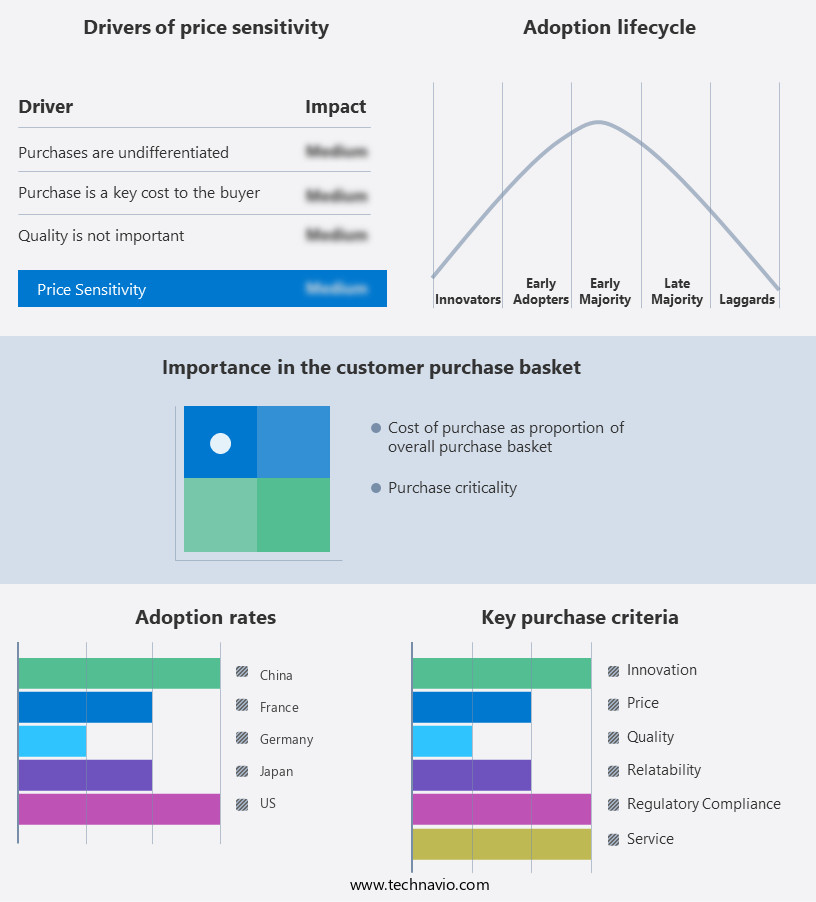
Customer Landscape of Industrial Automation Control Industry
Competitive Landscape & Market Insights
Companies are implementing various strategies, such as strategic alliances, industrial automation control market forecast, partnerships, mergers and acquisitions, geographical expansion, and product/service launches, to enhance their presence in the industry.
ABB Ltd. - The company specializes in industrial automation control, featuring solutions like Ability Genix. This technology enhances manufacturing efficiency through advanced analytics and real-time monitoring, enabling businesses to optimize processes and reduce operational costs.
The industry research and growth report includes detailed analyses of the competitive landscape of the market and information about key companies, including:
- ABB Ltd.
- Beckhoff Automation
- Bosch Rexroth AG
- Eaton Corp. plc
- Electrical4U
- Emerson Electric Co.
- Endress Hauser Group Services AG
- Fuji Electric Co. Ltd.
- General Electric Co.
- Hitachi Ltd.
- Honeywell International Inc.
- Industrial Automation Control
- Keyence India Pvt. Ltd.
- Novo Nordisk AS
- OMRON Corp.
- Rockwell Automation Inc.
- Schneider Electric SE
- Siemens AG
- Toshiba Corp.
- Yokogawa Electric Corp.
Qualitative and quantitative analysis of companies has been conducted to help clients understand the wider business environment as well as the strengths and weaknesses of key industry players. Data is qualitatively analyzed to categorize companies as pure play, category-focused, industry-focused, and diversified; it is quantitatively analyzed to categorize companies as dominant, leading, strong, tentative, and weak.
Recent Development and News in Industrial Automation Control Market
- In January 2024, Siemens AG, a leading industrial automation company, announced the launch of its new Simatic PCS 7 v23 Extended Automation Edition, integrating advanced digital services and edge computing capabilities (Siemens AG press release, 2024).
- In March 2024, Schneider Electric and Microsoft Corporation entered into a strategic partnership to integrate Schneider Electric's EcoStruxure architecture with Microsoft Azure for IoT and AI applications (Schneider Electric press release, 2024).
- In May 2024, Honeywell International Inc. Completed the acquisition of Novasoft Technologies, a leading provider of automation software for the process industries, expanding its software portfolio and market presence (Honeywell press release, 2024).
- In April 2025, ABB Ltd. Received regulatory approval for its acquisition of Baldor Electric Company, significantly increasing its presence in the US motor market and enhancing its electrification offering (ABB press release, 2025).
Dive into Technavio’s robust research methodology, blending expert interviews, extensive data synthesis, and validated models for unparalleled Industrial Automation Control Market insights. See full methodology.
|
Market Scope
|
|
Report Coverage
|
Details
|
|
Page number
|
233
|
|
Base year
|
2024
|
|
Historic period
|
2019-2023 |
|
Forecast period
|
2025-2029
|
|
Growth momentum & CAGR
|
Accelerate at a CAGR of 12.3%
|
|
Market growth 2025-2029
|
USD 160 billion
|
|
Market structure
|
Fragmented
|
|
YoY growth 2024-2025(%)
|
10.7
|
|
Key countries
|
US, China, Japan, Germany, India, Canada, Brazil, UK, South Korea, and France
|
|
Competitive landscape
|
Leading Companies, Market Positioning of Companies, Competitive Strategies, and Industry Risks
|
Request Free Sample
Research Analyst Overview
- In the ever-evolving landscape of industrial automation, several trends are shaping the market's dynamics. Machine vision technology, a critical component of automation, is gaining traction with its ability to enhance production efficiency and improve product quality. Digital twins, virtual replicas of physical assets, are increasingly being adopted for predictive maintenance and optimizing processes. Human-Machine Interface (HMI) design is undergoing a transformation, with a focus on intuitive and user-friendly interfaces. Cloud-based automation is another trend, enabling remote monitoring and control, reducing on-site personnel requirements. Feedback control loops and sensor integration are essential elements in process optimization, ensuring consistent performance and reducing downtime.
- Cybersecurity in automation is a growing concern, with the increasing adoption of digital technologies. Process automation, including SCADA systems and Safety Instrumented Systems (SIS), is becoming more sophisticated, incorporating real-time control and advanced control algorithms. Motion control and edge computing are enhancing the capabilities of industrial robots, while machine learning algorithms are improving energy efficiency and PLC programming. Industrial communication protocols, such as Industrial Ethernet and fieldbus networks, are enabling seamless data acquisition and actuator control. The integration of robotics and machine learning algorithms is revolutionizing manufacturing, leading to increased productivity and flexibility.
- In summary, the market is characterized by continuous innovation, with trends such as machine vision, digital twins, HMI design, cloud-based automation, cybersecurity, process optimization, and robotics integration shaping its evolution. These trends reflect the industry's ongoing commitment to enhancing efficiency, improving product quality, and reducing downtime.
What are the Key Data Covered in this Industrial Automation Control Market Research and Growth Report?
-
What is the expected growth of the Industrial Automation Control Market between 2025 and 2029?
-
What segmentation does the market report cover?
-
The report segmented by Product (Sensors, Drives, DCS, SCADA, and PLC), End-user (Process industry and Discrete industry), Component (Hardware, Software, and Services), and Geography (APAC, North America, Europe, South America, and Middle East and Africa)
-
Which regions are analyzed in the report?
-
APAC, North America, Europe, South America, and Middle East and Africa
-
What are the key growth drivers and market challenges?
-
Who are the major players in the Industrial Automation Control Market?
-
Key Companies ABB Ltd., Beckhoff Automation, Bosch Rexroth AG, Eaton Corp. plc, Electrical4U, Emerson Electric Co., Endress Hauser Group Services AG, Fuji Electric Co. Ltd., General Electric Co., Hitachi Ltd., Honeywell International Inc., Industrial Automation Control, Keyence India Pvt. Ltd., Novo Nordisk AS, OMRON Corp., Rockwell Automation Inc., Schneider Electric SE, Siemens AG, Toshiba Corp., and Yokogawa Electric Corp.
Market Research Insights
- The market encompasses a range of technologies and applications, including production efficiency, quality control, reliability analysis, operator training, safety standards, system diagnostics, control loop tuning, process optimization techniques, maintenance procedures, data logging, industrial automation software, system upgrade, data analytics, performance metrics, control system design, technical documentation, data visualization, real-time data processing, testing methodologies, industrial communication standards, system integration, system validation, alert management, fault detection, automation architectures, network security, and remote diagnostics. According to recent estimates, the market for PID controllers alone is projected to reach USD25 billion by 2025, growing at a compound annual growth rate of 4%.
- In contrast, the market for data analytics in industrial automation is expected to expand at a significantly higher CAGR of 12%, reaching USD60 billion by 2027. These figures underscore the importance of both traditional control systems and emerging data-driven technologies in optimizing industrial processes and enhancing operational efficiency.
We can help! Our analysts can customize this industrial automation control market research report to meet your requirements.
Get in touch
1 Executive Summary
- 1.1 Market overview
- Executive Summary - Chart on Market Overview
- Executive Summary - Data Table on Market Overview
- Executive Summary - Chart on Global Market Characteristics
- Executive Summary - Chart on Market by Geography
- Executive Summary - Chart on Market Segmentation by Product
- Executive Summary - Chart on Market Segmentation by End-user
- Executive Summary - Chart on Market Segmentation by Component
- Executive Summary - Chart on Incremental Growth
- Executive Summary - Data Table on Incremental Growth
- Executive Summary - Chart on Company Market Positioning
2 Technavio Analysis
- 2.1 Analysis of price sensitivity, lifecycle, customer purchase basket, adoption rates, and purchase criteria
- Analysis of price sensitivity, lifecycle, customer purchase basket, adoption rates, and purchase criteria
- 2.2 Criticality of inputs and Factors of differentiation
- Overview on criticality of inputs and factors of differentiation
- 2.3 Factors of disruption
- Overview on factors of disruption
- 2.4 Impact of drivers and challenges
- Impact of drivers and challenges in 2024 and 2029
3 Market Landscape
- 3.1 Market ecosystem
- Parent Market
- Data Table on - Parent Market
- 3.2 Market characteristics
- Market characteristics analysis
4 Market Sizing
- 4.1 Market definition
- Offerings of companies included in the market definition
- 4.2 Market segment analysis
- 4.4 Market outlook: Forecast for 2024-2029
- Chart on Global - Market size and forecast 2024-2029 ($ billion)
- Data Table on Global - Market size and forecast 2024-2029 ($ billion)
- Chart on Global Market: Year-over-year growth 2024-2029 (%)
- Data Table on Global Market: Year-over-year growth 2024-2029 (%)
5 Historic Market Size
- 5.1 Global Industrial Automation Control Market 2019 - 2023
- Historic Market Size - Data Table on Global Industrial Automation Control Market 2019 - 2023 ($ billion)
- 5.2 Product segment analysis 2019 - 2023
- Historic Market Size - Product Segment 2019 - 2023 ($ billion)
- 5.3 End-user segment analysis 2019 - 2023
- Historic Market Size - End-user Segment 2019 - 2023 ($ billion)
- 5.4 Component segment analysis 2019 - 2023
- Historic Market Size - Component Segment 2019 - 2023 ($ billion)
- 5.5 Geography segment analysis 2019 - 2023
- Historic Market Size - Geography Segment 2019 - 2023 ($ billion)
- 5.6 Country segment analysis 2019 - 2023
- Historic Market Size - Country Segment 2019 - 2023 ($ billion)
6 Qualitative Analysis
- 6.1 Impact of AI on global industrial automation control market
7 Five Forces Analysis
- 7.1 Five forces summary
- Five forces analysis - Comparison between 2024 and 2029
- 7.2 Bargaining power of buyers
- Bargaining power of buyers - Impact of key factors 2024 and 2029
- 7.3 Bargaining power of suppliers
- Bargaining power of suppliers - Impact of key factors in 2024 and 2029
- 7.4 Threat of new entrants
- Threat of new entrants - Impact of key factors in 2024 and 2029
- 7.5 Threat of substitutes
- Threat of substitutes - Impact of key factors in 2024 and 2029
- 7.6 Threat of rivalry
- Threat of rivalry - Impact of key factors in 2024 and 2029
- 7.7 Market condition
- Chart on Market condition - Five forces 2024 and 2029
8 Market Segmentation by Product
- 8.1 Market segments
- Chart on Product - Market share 2024-2029 (%)
- Data Table on Product - Market share 2024-2029 (%)
- 8.2 Comparison by Product
- Chart on Comparison by Product
- Data Table on Comparison by Product
- 8.3 Sensors - Market size and forecast 2024-2029
- Chart on Sensors - Market size and forecast 2024-2029 ($ billion)
- Data Table on Sensors - Market size and forecast 2024-2029 ($ billion)
- Chart on Sensors - Year-over-year growth 2024-2029 (%)
- Data Table on Sensors - Year-over-year growth 2024-2029 (%)
- 8.4 Drives - Market size and forecast 2024-2029
- Chart on Drives - Market size and forecast 2024-2029 ($ billion)
- Data Table on Drives - Market size and forecast 2024-2029 ($ billion)
- Chart on Drives - Year-over-year growth 2024-2029 (%)
- Data Table on Drives - Year-over-year growth 2024-2029 (%)
- 8.5 DCS - Market size and forecast 2024-2029
- Chart on DCS - Market size and forecast 2024-2029 ($ billion)
- Data Table on DCS - Market size and forecast 2024-2029 ($ billion)
- Chart on DCS - Year-over-year growth 2024-2029 (%)
- Data Table on DCS - Year-over-year growth 2024-2029 (%)
- 8.6 SCADA - Market size and forecast 2024-2029
- Chart on SCADA - Market size and forecast 2024-2029 ($ billion)
- Data Table on SCADA - Market size and forecast 2024-2029 ($ billion)
- Chart on SCADA - Year-over-year growth 2024-2029 (%)
- Data Table on SCADA - Year-over-year growth 2024-2029 (%)
- 8.7 PLC - Market size and forecast 2024-2029
- Chart on PLC - Market size and forecast 2024-2029 ($ billion)
- Data Table on PLC - Market size and forecast 2024-2029 ($ billion)
- Chart on PLC - Year-over-year growth 2024-2029 (%)
- Data Table on PLC - Year-over-year growth 2024-2029 (%)
- 8.8 Market opportunity by Product
- Market opportunity by Product ($ billion)
- Data Table on Market opportunity by Product ($ billion)
9 Market Segmentation by End-user
- 9.1 Market segments
- Chart on End-user - Market share 2024-2029 (%)
- Data Table on End-user - Market share 2024-2029 (%)
- 9.2 Comparison by End-user
- Chart on Comparison by End-user
- Data Table on Comparison by End-user
- 9.3 Process industry - Market size and forecast 2024-2029
- Chart on Process industry - Market size and forecast 2024-2029 ($ billion)
- Data Table on Process industry - Market size and forecast 2024-2029 ($ billion)
- Chart on Process industry - Year-over-year growth 2024-2029 (%)
- Data Table on Process industry - Year-over-year growth 2024-2029 (%)
- 9.4 Discrete industry - Market size and forecast 2024-2029
- Chart on Discrete industry - Market size and forecast 2024-2029 ($ billion)
- Data Table on Discrete industry - Market size and forecast 2024-2029 ($ billion)
- Chart on Discrete industry - Year-over-year growth 2024-2029 (%)
- Data Table on Discrete industry - Year-over-year growth 2024-2029 (%)
- 9.5 Market opportunity by End-user
- Market opportunity by End-user ($ billion)
- Data Table on Market opportunity by End-user ($ billion)
10 Market Segmentation by Component
- 10.1 Market segments
- Chart on Component - Market share 2024-2029 (%)
- Data Table on Component - Market share 2024-2029 (%)
- 10.2 Comparison by Component
- Chart on Comparison by Component
- Data Table on Comparison by Component
- 10.3 Hardware - Market size and forecast 2024-2029
- Chart on Hardware - Market size and forecast 2024-2029 ($ billion)
- Data Table on Hardware - Market size and forecast 2024-2029 ($ billion)
- Chart on Hardware - Year-over-year growth 2024-2029 (%)
- Data Table on Hardware - Year-over-year growth 2024-2029 (%)
- 10.4 Software - Market size and forecast 2024-2029
- Chart on Software - Market size and forecast 2024-2029 ($ billion)
- Data Table on Software - Market size and forecast 2024-2029 ($ billion)
- Chart on Software - Year-over-year growth 2024-2029 (%)
- Data Table on Software - Year-over-year growth 2024-2029 (%)
- 10.5 Services - Market size and forecast 2024-2029
- Chart on Services - Market size and forecast 2024-2029 ($ billion)
- Data Table on Services - Market size and forecast 2024-2029 ($ billion)
- Chart on Services - Year-over-year growth 2024-2029 (%)
- Data Table on Services - Year-over-year growth 2024-2029 (%)
- 10.6 Market opportunity by Component
- Market opportunity by Component ($ billion)
- Data Table on Market opportunity by Component ($ billion)
11 Customer Landscape
- 11.1 Customer landscape overview
- Analysis of price sensitivity, lifecycle, customer purchase basket, adoption rates, and purchase criteria
12 Geographic Landscape
- 12.1 Geographic segmentation
- Chart on Market share by geography 2024-2029 (%)
- Data Table on Market share by geography 2024-2029 (%)
- 12.2 Geographic comparison
- Chart on Geographic comparison
- Data Table on Geographic comparison
- 12.3 APAC - Market size and forecast 2024-2029
- Chart on APAC - Market size and forecast 2024-2029 ($ billion)
- Data Table on APAC - Market size and forecast 2024-2029 ($ billion)
- Chart on APAC - Year-over-year growth 2024-2029 (%)
- Data Table on APAC - Year-over-year growth 2024-2029 (%)
- 12.4 North America - Market size and forecast 2024-2029
- Chart on North America - Market size and forecast 2024-2029 ($ billion)
- Data Table on North America - Market size and forecast 2024-2029 ($ billion)
- Chart on North America - Year-over-year growth 2024-2029 (%)
- Data Table on North America - Year-over-year growth 2024-2029 (%)
- 12.5 Europe - Market size and forecast 2024-2029
- Chart on Europe - Market size and forecast 2024-2029 ($ billion)
- Data Table on Europe - Market size and forecast 2024-2029 ($ billion)
- Chart on Europe - Year-over-year growth 2024-2029 (%)
- Data Table on Europe - Year-over-year growth 2024-2029 (%)
- 12.6 South America - Market size and forecast 2024-2029
- Chart on South America - Market size and forecast 2024-2029 ($ billion)
- Data Table on South America - Market size and forecast 2024-2029 ($ billion)
- Chart on South America - Year-over-year growth 2024-2029 (%)
- Data Table on South America - Year-over-year growth 2024-2029 (%)
- 12.7 Middle East and Africa - Market size and forecast 2024-2029
- Chart on Middle East and Africa - Market size and forecast 2024-2029 ($ billion)
- Data Table on Middle East and Africa - Market size and forecast 2024-2029 ($ billion)
- Chart on Middle East and Africa - Year-over-year growth 2024-2029 (%)
- Data Table on Middle East and Africa - Year-over-year growth 2024-2029 (%)
- 12.8 US - Market size and forecast 2024-2029
- Chart on US - Market size and forecast 2024-2029 ($ billion)
- Data Table on US - Market size and forecast 2024-2029 ($ billion)
- Chart on US - Year-over-year growth 2024-2029 (%)
- Data Table on US - Year-over-year growth 2024-2029 (%)
- 12.9 China - Market size and forecast 2024-2029
- Chart on China - Market size and forecast 2024-2029 ($ billion)
- Data Table on China - Market size and forecast 2024-2029 ($ billion)
- Chart on China - Year-over-year growth 2024-2029 (%)
- Data Table on China - Year-over-year growth 2024-2029 (%)
- 12.10 Japan - Market size and forecast 2024-2029
- Chart on Japan - Market size and forecast 2024-2029 ($ billion)
- Data Table on Japan - Market size and forecast 2024-2029 ($ billion)
- Chart on Japan - Year-over-year growth 2024-2029 (%)
- Data Table on Japan - Year-over-year growth 2024-2029 (%)
- 12.11 Germany - Market size and forecast 2024-2029
- Chart on Germany - Market size and forecast 2024-2029 ($ billion)
- Data Table on Germany - Market size and forecast 2024-2029 ($ billion)
- Chart on Germany - Year-over-year growth 2024-2029 (%)
- Data Table on Germany - Year-over-year growth 2024-2029 (%)
- 12.12 India - Market size and forecast 2024-2029
- Chart on India - Market size and forecast 2024-2029 ($ billion)
- Data Table on India - Market size and forecast 2024-2029 ($ billion)
- Chart on India - Year-over-year growth 2024-2029 (%)
- Data Table on India - Year-over-year growth 2024-2029 (%)
- 12.13 Canada - Market size and forecast 2024-2029
- Chart on Canada - Market size and forecast 2024-2029 ($ billion)
- Data Table on Canada - Market size and forecast 2024-2029 ($ billion)
- Chart on Canada - Year-over-year growth 2024-2029 (%)
- Data Table on Canada - Year-over-year growth 2024-2029 (%)
- 12.14 Brazil - Market size and forecast 2024-2029
- Chart on Brazil - Market size and forecast 2024-2029 ($ billion)
- Data Table on Brazil - Market size and forecast 2024-2029 ($ billion)
- Chart on Brazil - Year-over-year growth 2024-2029 (%)
- Data Table on Brazil - Year-over-year growth 2024-2029 (%)
- 12.15 UK - Market size and forecast 2024-2029
- Chart on UK - Market size and forecast 2024-2029 ($ billion)
- Data Table on UK - Market size and forecast 2024-2029 ($ billion)
- Chart on UK - Year-over-year growth 2024-2029 (%)
- Data Table on UK - Year-over-year growth 2024-2029 (%)
- 12.16 South Korea - Market size and forecast 2024-2029
- Chart on South Korea - Market size and forecast 2024-2029 ($ billion)
- Data Table on South Korea - Market size and forecast 2024-2029 ($ billion)
- Chart on South Korea - Year-over-year growth 2024-2029 (%)
- Data Table on South Korea - Year-over-year growth 2024-2029 (%)
- 12.17 France - Market size and forecast 2024-2029
- Chart on France - Market size and forecast 2024-2029 ($ billion)
- Data Table on France - Market size and forecast 2024-2029 ($ billion)
- Chart on France - Year-over-year growth 2024-2029 (%)
- Data Table on France - Year-over-year growth 2024-2029 (%)
- 12.18 Market opportunity by geography
- Market opportunity by geography ($ billion)
- Data Tables on Market opportunity by geography ($ billion)
13 Drivers, Challenges, and Opportunity/Restraints
- 13.3 Impact of drivers and challenges
- Impact of drivers and challenges in 2024 and 2029
- 13.4 Market opportunities/restraints
14 Competitive Landscape
- 14.2 Competitive Landscape
- Overview on criticality of inputs and factors of differentiation
- 14.3 Landscape disruption
- Overview on factors of disruption
- 14.4 Industry risks
- Impact of key risks on business
15 Competitive Analysis
- 15.2 Company ranking index
- 15.3 Market positioning of companies
- Matrix on companies position and classification
- 15.4 ABB Ltd.
- ABB Ltd. - Overview
- ABB Ltd. - Business segments
- ABB Ltd. - Key news
- ABB Ltd. - Key offerings
- ABB Ltd. - Segment focus
- SWOT
- 15.5 Beckhoff Automation
- Beckhoff Automation - Overview
- Beckhoff Automation - Product / Service
- Beckhoff Automation - Key offerings
- SWOT
- 15.6 Eaton Corp. plc
- Eaton Corp. plc - Overview
- Eaton Corp. plc - Business segments
- Eaton Corp. plc - Key news
- Eaton Corp. plc - Key offerings
- Eaton Corp. plc - Segment focus
- SWOT
- 15.7 Emerson Electric Co.
- Emerson Electric Co. - Overview
- Emerson Electric Co. - Business segments
- Emerson Electric Co. - Key news
- Emerson Electric Co. - Key offerings
- Emerson Electric Co. - Segment focus
- SWOT
- 15.8 Endress Hauser Group Services AG
- Endress Hauser Group Services AG - Overview
- Endress Hauser Group Services AG - Product / Service
- Endress Hauser Group Services AG - Key news
- Endress Hauser Group Services AG - Key offerings
- SWOT
- 15.9 Fuji Electric Co. Ltd.
- Fuji Electric Co. Ltd. - Overview
- Fuji Electric Co. Ltd. - Business segments
- Fuji Electric Co. Ltd. - Key news
- Fuji Electric Co. Ltd. - Key offerings
- Fuji Electric Co. Ltd. - Segment focus
- SWOT
- 15.10 General Electric Co.
- General Electric Co. - Overview
- General Electric Co. - Business segments
- General Electric Co. - Key news
- General Electric Co. - Key offerings
- General Electric Co. - Segment focus
- SWOT
- 15.11 Hitachi Ltd.
- Hitachi Ltd. - Overview
- Hitachi Ltd. - Business segments
- Hitachi Ltd. - Key news
- Hitachi Ltd. - Key offerings
- Hitachi Ltd. - Segment focus
- SWOT
- 15.12 Honeywell International Inc.
- Honeywell International Inc. - Overview
- Honeywell International Inc. - Business segments
- Honeywell International Inc. - Key news
- Honeywell International Inc. - Key offerings
- Honeywell International Inc. - Segment focus
- SWOT
- 15.13 Keyence India Pvt. Ltd.
- Keyence India Pvt. Ltd. - Overview
- Keyence India Pvt. Ltd. - Product / Service
- Keyence India Pvt. Ltd. - Key offerings
- SWOT
- 15.14 OMRON Corp.
- OMRON Corp. - Overview
- OMRON Corp. - Business segments
- OMRON Corp. - Key news
- OMRON Corp. - Key offerings
- OMRON Corp. - Segment focus
- SWOT
- 15.15 Rockwell Automation Inc.
- Rockwell Automation Inc. - Overview
- Rockwell Automation Inc. - Business segments
- Rockwell Automation Inc. - Key news
- Rockwell Automation Inc. - Key offerings
- Rockwell Automation Inc. - Segment focus
- SWOT
- 15.16 Schneider Electric SE
- Schneider Electric SE - Overview
- Schneider Electric SE - Business segments
- Schneider Electric SE - Key news
- Schneider Electric SE - Key offerings
- Schneider Electric SE - Segment focus
- SWOT
- 15.17 Siemens AG
- Siemens AG - Overview
- Siemens AG - Business segments
- Siemens AG - Key news
- Siemens AG - Key offerings
- Siemens AG - Segment focus
- SWOT
- 15.18 Yokogawa Electric Corp.
- Yokogawa Electric Corp. - Overview
- Yokogawa Electric Corp. - Business segments
- Yokogawa Electric Corp. - Key news
- Yokogawa Electric Corp. - Key offerings
- Yokogawa Electric Corp. - Segment focus
- SWOT
16 Appendix
- 16.2 Inclusions and exclusions checklist
- Inclusions checklist
- Exclusions checklist
- 16.3 Currency conversion rates for US$
- Currency conversion rates for US$
- 16.4 Research methodology
- 16.7 Validation techniques employed for market sizing
- Validation techniques employed for market sizing
- 16.9 360 degree market analysis
- 360 degree market analysis
- 16.10 List of abbreviations







![]() Get the report (PDF) sent to your email within minutes.
Get the report (PDF) sent to your email within minutes.
Complimentary full Excel data with your report purchase.